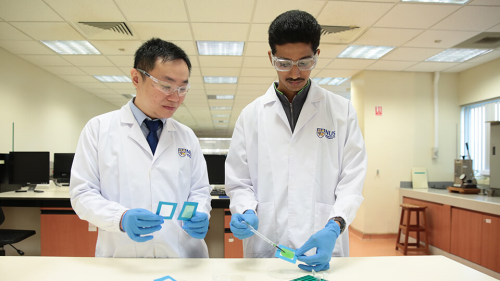
VIDEO: High-quality air filter removes harmful particles, enhances air flow and reduces UV rays.
The nanofibre-based thin, transparent air filters can remove up to 90% of particles less than 2.5 µm in size (known as PM2.5 particles), which are associated with serious health risks, and achieve 2.5 times better air flow than conventional air filters.
The filters could be used in the windows and doors of buildings to improve indoor air quality, especially in countries experiencing high pollution levels. They also have promising applications in respirators.
Novel nanofibres
The researchers from NUS's Faculty of Engineering report that the air filter is easy to produce by simply by applying a novel nanofibre solution onto a nonwoven mesh, and leaving it to dry naturally. Using phthalocyanine, a chemical compound commonly used in dyeing, the NUS team engineered organic molecules that could self-organise, similar to the stacking of building blocks, to form nanoparticles and subsequently, nanofibres. These nanofibres, which exist in the form of an organic solution, easily 'cling' onto the nonwoven mesh when dispersed onto the material.
"Currently, most nanofibres used in air filters are energy intensive to produce and require specialised equipment," explains Assistant Professor Tan Swee Ching from the Department of Materials Science and Engineering at the NUS Faculty of Engineering, who led the research.
"Our team has developed a simple, quick and cost-effective way of producing high-quality air filters that effectively remove harmful particles and further improves indoor air quality by enhancing air ventilation and reducing harmful UV rays."
High efficiency
Air filters are generally gauged by a parameter called quality factor, which is dependent on their particle filtration efficiency and air permeability. Current commercial respirators have a high particle filtration efficiency, but their air permeability is low, thus resulting in a low quality factor.
The NUS air filter achieves a quality factor of about two times higher than commercial respirators.
“High-efficiency air filters often requires multiple layers of microfibres or nanofibres, thus limiting their transparency and as such, they are not suitable to be incorporated in doors and windows of buildings," explains Assistant Professor Tan.
"The see-through air filter developed using our approach has promising applications in terms of improving indoor air quality, and could be especially useful for countries experiencing haze or with high pollution levels. While increasing filtration efficiency will lead to a trade-off in air flow, the overall performance of our air filter is still better than commercial respirators.”
Commercialisation
The NUS research team has filed a patent for this filter and is planning to work with industry partners to commercialise the technology.
The researchers are also looking into adding more functionalities, such as anti-bacterial properties, into the air filter. They believe, in the long run, it may even be possible for a DIY kit to be made available commercially for consumers to make air filters at home.
The findings of their study have been published in the online version of the journal Small.





